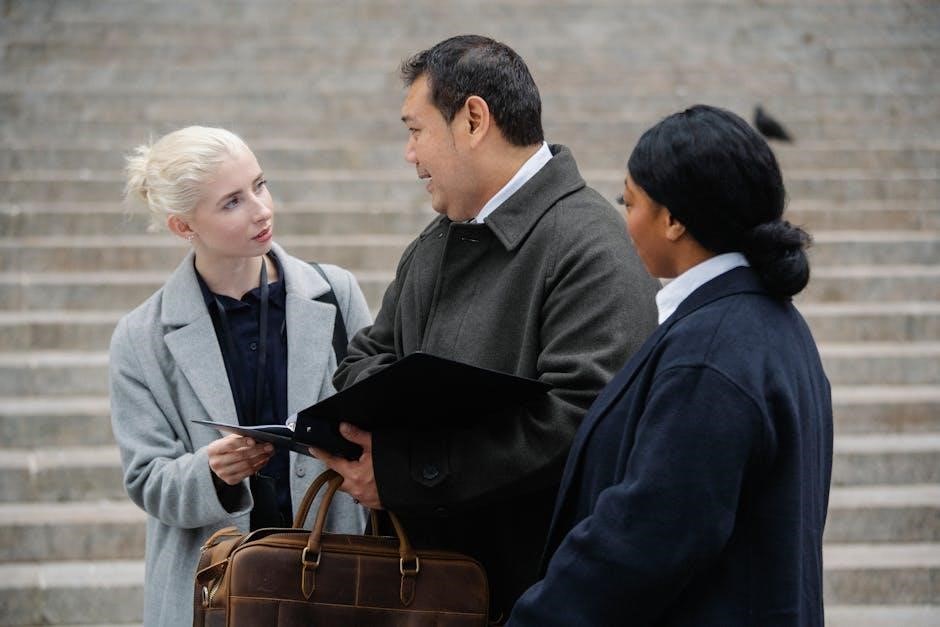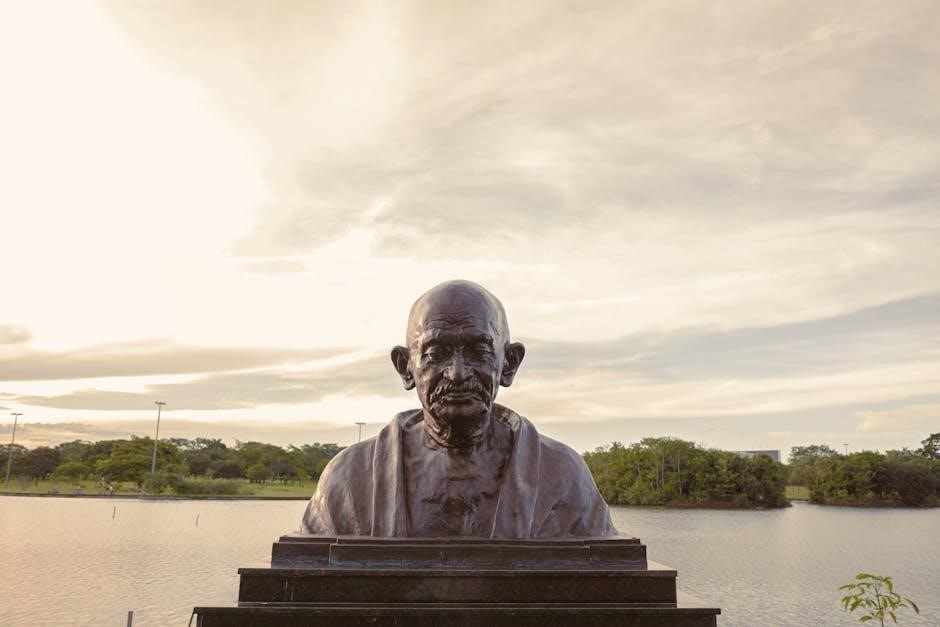
gang leader for a day pdf
Sudhir Venkatesh’s memoir offers a gripping account of life in Chicago’s housing projects, blending personal narrative with sociological insight into urban poverty and gang culture․
- Explores the author’s unexpected relationship with a gang leader․
- Provides a unique perspective on the complexities of gang life․
- Highlights the challenges of embedded ethnographic research in dangerous environments․
1․1 Overview of the Book
Gang Leader for a Day by Sudhir Venkatesh is a memoir that chronicles the author’s six-year immersion in Chicago’s housing projects․ The book offers a unique blend of personal narrative and sociological study, exploring the complexities of urban poverty, gang culture, and the daily struggles of those living in marginalized communities․ Venkatesh’s experiences, from witnessing drive-bys to understanding the internal dynamics of gangs, provide a raw and unfiltered look at life in the projects․ The book raises critical questions about ethics, race, and the societal structures that perpetuate inequality, offering a compelling and thought-provoking perspective on urban America․
1․2 Author Background: Sudhir Venkatesh
Sudhir Venkatesh is a sociologist and professor known for his groundbreaking research on urban poverty and gangs․ Born in India, he moved to the U․S․ and studied at the University of Chicago, where his work in the city’s housing projects formed the basis of Gang Leader for a Day․ His unique approach to ethnography has earned him both acclaim and criticism, as he often immerses himself in dangerous environments to gather data․ Venkatesh’s work challenges conventional notions of race, class, and crime, offering a nuanced understanding of marginalized communities․
1․3 Key Themes and Objectives
Gang Leader for a Day explores themes of urban poverty, gang culture, and the ethical dilemmas of embedded research․ Venkatesh examines how gangs operate as informal economies and social structures, providing both protection and exploitation․ He also delves into the moral challenges faced by researchers in dangerous settings, questioning the boundaries between observer and participant․ The book aims to humanize gang members and challenge stereotypes, offering a deeper understanding of life in marginalized communities while reflecting on the complexities of sociological fieldwork․

The Sociological Context
Gang Leader for a Day examines urban poverty, housing projects, and gang dynamics, revealing how societal neglect fosters criminal ecosystems and shapes community survival strategies in marginalized areas․
2․1 Life in Chicago Housing Projects
Chicago’s housing projects were marked by extreme poverty, neglect, and crime, creating an environment where gangs thrived as both predators and protectors․ Residents faced daily struggles for survival, with limited access to basic necessities․ The projects became a microcosm of urban decay, where societal failures allowed gangs to fill power vacuums․ Venkatesh’s work captures the stark realities of life in these communities, where violence and resilience coexisted, shaping the social fabric of the area․ This backdrop is crucial for understanding the context of gang operations and their impact on residents․
2․2 The Role of Gangs in Urban Communities
Gangs in urban communities like Chicago’s housing projects often serve as both predators and protectors, exerting control over neighborhoods through fear and intimidation․ They regulate drug trades, prostitution, and other illegal activities, while also providing a form of order in areas where formal governance is absent․ This duality creates a complex dynamic, where gangs are simultaneously feared and relied upon by residents․ Their presence shapes community life, fostering a culture of survival and resilience, but also perpetuating cycles of violence and instability that challenge law enforcement and social structures․
2․3 Ethnographic Research Methods
Sudhir Venkatesh’s work in Gang Leader for a Day employs immersive ethnographic research, where he embedded himself in Chicago’s housing projects for six years․ His approach involved direct participation in gang activities, observing drug deals, drive-bys, and internal conflicts․ This method allowed him to gather intimate details about gang dynamics, offering a unique perspective on urban life․ Venkatesh’s embedded participation provided rich insights into the complexities of gang culture, balancing observation with personal involvement to uncover the harsh realities and hidden nuances of this hidden world․
- His research highlights the challenges of gaining trust in dangerous environments․
- It also raises ethical questions about the role of the researcher in such settings․

The Gang Leader’s World
The gang leader’s world revolves around power, survival, and control, navigating daily challenges of drug trades, violence, and internal conflicts while maintaining a fragile social order․
- Daily life includes managing disputes and ensuring loyalty within the gang․
- The leader must balance harsh realities with moments of camaraderie and shared purpose․
3․1 Daily Life as a Gang Leader
Daily life as a gang leader involves constant vigilance, strategic decision-making, and balancing power dynamics․ From mediating disputes to organizing drug operations, the leader must maintain control and loyalty․
- Manages disputes within the gang and with rival groups to avoid escalation․
- Oversees drug trades, ensuring profitability and minimizing risks of police intervention․
- Enforces discipline, often through violence, to maintain order and authority․
- Navigates the emotional toll of a life marked by violence and uncertainty․
3․2 Prostitution, Drug Trades, and Violence
Gangs dominate urban economies through prostitution and drug trades, which are often intertwined with violence․ These activities provide financial stability but also attract law enforcement and rival gangs․
- Prostitution rings are controlled by gang leaders, offering a steady income source․
- Drug trades operate with hierarchical structures, ensuring efficiency and profitability․
- Violence is used to protect territories, resolve conflicts, and maintain fear․
- These illegal activities create a cycle of dependency and danger for all involved․
3․3 Internal Gang Dynamics and Conflicts
Gangs operate with complex internal hierarchies, where power struggles and loyalty tests are constant․ Conflicts often arise over territorial disputes, financial control, and leadership challenges․
- Leaders maintain authority through fear and strategic decision-making․
- Rivalries within the gang can lead to violent internal discipline․
- Economic disputes, such as drug trade profits, frequently escalate tensions․
- These dynamics reveal a fragile balance between unity and fragmentation․

Sudhir Venkatesh’s Journey
Sudhir Venkatesh’s immersive research in Chicago’s housing projects transformed his sociological perspective, offering raw insights into urban life and gang culture through personal experiences and challenges․
4․1 How He Gained Access to the Gang
Sudhir Venkatesh initially struggled to penetrate the gang’s inner circle, facing skepticism and hostility․ His persistence and curiosity eventually caught the attention of a gang leader, who invited him to observe their operations․ Over time, Venkatesh built trust by demonstrating respect and a genuine interest in understanding their lives․ This access allowed him to witness firsthand the dynamics of gang life, from daily operations to internal conflicts, providing unique insights into their world․
- Initial skepticism from gang members․
- Building trust through persistence and respect․
- Gaining unprecedented access to gang activities․
4․2 Witnessing Drive-Bys and Crack Deals
Venkatesh immersed himself in the gang’s world, witnessing firsthand the harsh realities of urban violence and narcotics․ He observed drive-by shootings, crack deals, and the constant presence of law enforcement․ These experiences revealed the dangerous yet routine nature of life within the gang, highlighting the intersections of crime, survival, and community dynamics․ His observations underscored the resilience and resourcefulness of gang members, while also exposing the cyclical nature of violence and its impact on the community․
- Exposure to drive-by shootings and crack deals․
- Understanding the routine of urban violence․
- Interactions with law enforcement and community dynamics․
4․4 Struggles as a Doctoral Student
Venkatesh faced significant challenges balancing his academic responsibilities with his immersive fieldwork․ Managing the demands of his doctoral program while navigating the dangers of gang life created emotional and intellectual strain․ He often grappled with reconciling his role as a researcher with the ethical dilemmas of his work, particularly when witnessing illegal activities․ These struggles highlighted the tensions between academic rigor and the realities of embedded research in high-risk environments․
- Academic pressures alongside dangerous fieldwork․
- Reconciling research demands with personal responsibilities․
- Emotional toll of documenting illegal activities․

The Portrayal of Gang Life
The book vividly captures the dual nature of gang life, revealing both its brutal violence and unexpected moments of camaraderie and loyalty among members․
5․1 The Harsh Realities of Gang Membership
The harsh realities of gang membership are vividly portrayed through violent encounters, constant threats, and the ever-present specter of arrest or death․ Members often face brutal treatment, both from within the gang and from external threats․ The environment is fraught with danger, where even minor disputes can escalate into deadly conflicts․ Sudhir Venkatesh’s account highlights the physical and psychological tolls on gang members, including the moral dilemmas faced when witnessing or participating in illegal activities․ This raw portrayal underscores the unforgiving nature of gang life, emphasizing survival as a daily struggle․
- Violent encounters and constant threats are commonplace․
- Members face brutal treatment from both within and outside the gang․
- Minor disputes can quickly escalate into deadly conflicts․
- Physical and psychological tolls on gang members are evident․
- Moral dilemmas arise from witnessing or participating in illegal activities․
- Survival becomes a daily struggle in this unforgiving environment․
5․2 The Softer Side of Gang Life
Amid the chaos, Sudhir Venkatesh uncovers the softer side of gang life, revealing bonds of camaraderie and shared humanity․ Gang members often form strong personal connections, with loyalty and trust emerging as crucial values․ The author highlights moments of vulnerability, where members support each other through personal struggles or celebrate shared successes․ These dynamics humanize the gang, showcasing a complex interplay of toughness and tenderness that goes beyond the typical narratives of violence and crime․
- Gang members form strong bonds of loyalty and trust․
- Shared struggles and celebrations reveal a sense of camaraderie․
- Moments of vulnerability humanize the gang’s image․
- These dynamics highlight a complex interplay of toughness and tenderness․
5․3 The Role of Money in Gang Operations
Money is the lifeblood of gang operations, driving activities from drug trades to turf wars․ Sudhir Venkatesh reveals how gangs meticulously manage finances, allocating funds for weapons, bribes, and even community handouts․ Profit motives often clash with personal loyalty, creating internal conflicts․ The pursuit of wealth also attracts new members, perpetuating a cycle of crime and economic dependency that shapes the gang’s structure and survival in urban environments․
- Financial management is crucial for gang sustainability․
- Money funds weapons, bribes, and community gestures․
- Profit motives often lead to internal power struggles․
- Economic dependency perpetuates the gang’s cycle of crime․

The Community’s Perspective
The community’s view of gangs is complex, ranging from fear to reliance․ Residents often see gangs as both protectors and predators, creating a paradoxical relationship․
6․1 Relationships Between Gangs and Residents
In Gang Leader for a Day, Sudhir Venkatesh explores the complex dynamic between gangs and residents in Chicago housing projects․ While gangs often provide a sense of security and order, their presence also brings fear and instability․ Residents frequently walk a fine line, relying on gangs for protection yet suffering from their violence and exploitation․ This tense relationship is further complicated by economic dependencies, as gangs sometimes control local businesses, impacting residents’ livelihoods․ Venkatesh’s observations reveal how deeply intertwined gang activity is with community life, creating moral dilemmas for those caught in this web․ The book highlights how gangs can both oppress and be seen as protectors, reflecting the broader challenges of urban poverty and lack of trust in law enforcement․
6․2 The Impact of Gangs on Local Businesses
Gangs significantly influence local businesses in Chicago’s housing projects, as detailed in Gang Leader for a Day․ Many businesses operate under the threat of extortion, with gangs demanding protection money․ This creates a precarious environment where entrepreneurs struggle to sustain their operations․ Some businesses thrive by catering to the gang economy, such as those involved in drug trade logistics․ However, this relationship often leads to cycles of violence and instability, further undermining economic stability in already impoverished areas․ Venkatesh’s account illustrates how gangs both exploit and depend on local commerce, perpetuating a cycle of dependency and conflict․ This dynamic underscores the broader challenges of urban poverty and the lack of viable economic opportunities for residents․
6․3 The Role of Women in the Community
In Gang Leader for a Day, women play a vital yet often overlooked role in maintaining community stability․ Many act as mediators, resolving disputes and fostering cohesion among residents․ They also manage households and provide emotional support, often serving as the backbone of families․ Some women are involved in informal economies, including those tied to gang activities, such as drug trade logistics․ Despite their contributions, their influence is frequently undervalued, reflecting broader societal disparities faced by women in impoverished urban areas․ Their resilience and resourcefulness are central to survival in these challenging environments․
- Mediators in community conflicts․
- Managers of households and emotional support systems․
- Participants in informal economies, including gang-related activities․

Law Enforcement and Gangs
Corruption and collusion between law enforcement and gangs are prevalent, undermining trust․ Police strategies often focus on suppression, while cycles of violence and retaliation persist, complicating resolution․
- Corruption within law enforcement․
- Strategies to combat gang activity․
- Cycle of violence and retaliation․
7․1 Corruption and Collusion
Law enforcement corruption and collusion with gangs are starkly revealed in Venkatesh’s account․ Police often turn a blind eye to drug trades, accepting bribes or actively participating in criminal activities․
- Police officers accepting bribes from gang members․
- Law enforcement facilitating drug operations for personal gain․
- Corruption undermining efforts to combat gang-related crime․
This collusion perpetuates a cycle of violence and mistrust within urban communities, as residents lose faith in authorities meant to protect them;
7․2 Police Strategies to Combat Gang Activity
Police employ various strategies to address gang activity, including targeted patrols, intelligence-gathering, and community engagement programs․ These efforts aim to disrupt gang operations and rebuild trust with residents․
- Increased police presence in high-crime areas to deter gang activity․
- Use of undercover operations to infiltrate and gather evidence on gangs․
- Community outreach initiatives to prevent youth recruitment and promote alternatives to gang life․
These strategies often face challenges, including resource limitations and the need for sustained engagement to achieve long-term results․
7․3 The Cycle of Violence and Retaliation
The cycle of violence and retaliation in gang-dominated areas perpetuates endless conflict, with each attack prompting a more severe response․ This escalation often stems from disputes over territory, respect, or economic control․
- Drive-by shootings and targeted assassinations are common forms of retaliation․
- Violence disrupts community life, fostering fear and mistrust among residents․
- Breaking this cycle requires addressing root causes like poverty and lack of opportunities․
Without interventions, the cycle of vengeance continues, trapping communities in a deadly loop of violence and instability․

The Drug Trade Dynamics
The drug trade operates as a lucrative yet perilous enterprise, deeply entrenched in impoverished neighborhoods, with gangs controlling distribution networks and enforcing territorial boundaries through violence․
- Gangs dominate local drug markets, often clashing over profitable territories․
- Violence and intimidation maintain control, discouraging competition and police interference․
- The cycle of drug-related violence perpetuates instability and economic exploitation․
8․1 How the Drug Trade Operates
The drug trade in urban areas functions through hierarchical networks, with gang leaders overseeing distribution, enforcers maintaining control, and street-level dealers handling sales to users․
- Gangs establish territories, often dividing neighborhoods into zones of operation․
- Drug supplies are sourced from higher-level distributors, with profits filtered up the chain․
- Law enforcement corruption sometimes enables operations, while rival gangs pose constant threats․
- Violence is a tool to maintain dominance and eliminate competition․
8․2 The Role of Gangs in the Drug Economy
Gangs are central to the urban drug economy, controlling distribution networks and maintaining power through intimidation and violence․ They regulate supply chains, enforce territorial boundaries, and mediate disputes․ Profits from drug sales fund gang operations, including weapons and bribes․ Gang leaders often act as entrepreneurs, balancing risks and rewards in a volatile market․ Their involvement perpetuates cycles of poverty and violence, while also creating a sense of order within chaotic environments․ This dual role underscores the complex interplay between economic necessity and criminal enterprise․
8․3 The Consequences of Drug-Related Violence
Drug-related violence destabilizes communities, causing physical harm, emotional trauma, and economic disruption․ It perpetuates cycles of retaliation, creating a climate of fear and mistrust․ Innocent bystanders, including children, often suffer, while local businesses struggle to operate amidst the chaos․ The violence exacerbates social inequalities, deepening poverty and limiting opportunities for escape․ It also strains relationships between law enforcement and residents, further entrenching systemic issues․ The toll on individuals and families is immeasurable, leaving lasting scars on both personal lives and community fabric․

The Author’s Reflections
Venkatesh reflects on his personal growth, grappling with moral dilemmas, and the ethical challenges of embedded research․ His journey reveals profound lessons about humanity and urban inequality․
9․1 Moral Dilemmas Faced by Venkatesh
Venkatesh grappled with profound moral dilemmas during his research, often caught between his role as an observer and the harsh realities of gang life․ He witnessed drive-bys, prostitution, and drug deals, forcing him to question his neutrality․ The internal conflicts of the gang, including violence against members, further complicated his ethical stance․ Venkatesh also struggled with the moral implications of his presence, wondering if his involvement inadvertently enabled criminal activity․ These dilemmas highlighted the blurred lines between research and complicity in a dangerous world․
9․2 The Ethical Challenges of Embedded Research
Venkatesh’s embedded research posed significant ethical challenges, as he navigated the fine line between participation and observation․ Gaining the trust of gang members required him to blur his identity, raising questions about objectivity and detachment․ The risks of physical harm and legal repercussions were constant, while the emotional toll of witnessing violence and exploitation added another layer of complexity․ These challenges underscored the moral ambiguities inherent in immersive research, where the pursuit of knowledge often conflicts with personal and professional ethics․
9․3 Personal Growth and Lessons Learned
Venkatesh’s journey through the gang world profoundly shaped his perspective on humanity and academia․ He learned to navigate extreme environments, fostering resilience and empathy․ The experience highlighted the complexities of urban life, revealing both the harsh realities of poverty and the resilience of those trapped within it․ These lessons transformed his approach to research, emphasizing the importance of understanding over judgment and the value of human stories in sociological inquiry․

The Book’s Reception
“Gang Leader for a Day” received widespread acclaim for its raw portrayal of urban life, sparking debates on ethics and societal issues․ Critics praised its honesty and depth, while some questioned its controversial themes, leading to mixed public reactions and significant media attention․
10․1 Critical Reviews and Praise
Critics widely praised Gang Leader for a Day for its unflinching portrayal of urban life․ Reviewers noted its unique blend of sociological insight and personal narrative, calling it a “riveting” and “eye-opening” account․ The book was lauded for its ability to humanize gang members, offering a nuanced perspective on their lives․ Venkatesh’s courage and ethical dilemmas were highlighted, with many commending his immersive research․ The memoir received accolades for its thought-provoking commentary on poverty, violence, and societal structures․
10․2 Controversies and Criticisms
The book faced criticism for its portrayal of gang life, with some accusing Venkatesh of crossing ethical boundaries․ Critics argued his deep embedding with the gang raised questions about his influence on events․ Others felt the narrative romanticized gang culture, potentially misleading readers about its harsh realities․ Additionally, some scholars criticized Venkatesh’s methods, suggesting they blurred the line between observation and participation, raising concerns about exploitation and the ethics of immersive research in vulnerable communities․
10․3 Public Perception and Popularity
“Gang Leader for a Day” gained significant popularity, resonating with readers for its raw, unfiltered portrayal of urban life․ Many praised its ability to humanize gang members, offering a nuanced perspective beyond stereotypes․ The book sparked widespread discussions about poverty, crime, and societal structures․ While some critics debated its ethical implications, the memoir remains a bestseller, praised for its storytelling and sociological depth․ Its popularity has endured, making it a influential work in both academic and mainstream circles, shedding light on often overlooked communities․
The Impact of the Book
“Gang Leader for a Day” significantly influenced public policy discussions on urban poverty and gang violence, raising awareness and inspiring further research in sociology and criminology․
11․1 Contributions to Sociology and Criminology
Sudhir Venkatesh’s work in Gang Leader for a Day has significantly enriched the fields of sociology and criminology by offering unparalleled insights into urban gang dynamics․ His embedded research methodology provided a detailed understanding of the social structures and economic systems within gangs, challenging stereotypes and offering a nuanced perspective on urban poverty․ The book has been widely praised for its innovative approach and has influenced subsequent studies on marginalized communities, making it a seminal work in contemporary sociological research․
11․2 Influence on Public Policy and Awareness
Gang Leader for a Day has significantly influenced public policy by shedding light on the complexities of urban poverty and gang life․ Venkatesh’s findings have sparked discussions on alternative approaches to law enforcement and community development․ The book has also raised public awareness, challenging stereotypes about gangs and encouraging empathy for marginalized communities․ Its insights have inspired policymakers to reconsider strategies for addressing urban violence and poverty, fostering a more informed dialogue about societal interventions․
- Highlighted the need for community-based solutions․
- Encouraged rethinking law enforcement strategies․
- Supported public awareness campaigns about urban challenges․
- Encouraged interdisciplinary research approaches․
- Fostered debates on urban sociology and policy․
- Inspired new methodologies in ethnographic studies․
11․3 Inspiring Further Research and Discussions
Gang Leader for a Day has become a catalyst for further research into urban sociology and criminology․ Venkatesh’s immersive approach has inspired scholars to explore gang dynamics, poverty, and community relationships․ The book’s vivid narratives have sparked debates among researchers, policymakers, and the public, fostering a deeper understanding of urban challenges․ Its impact continues to drive interdisciplinary studies, encouraging innovative methodologies in understanding marginalized communities and their struggles․
Gang Leader for a Day offers profound insights into urban poverty, gangs, and societal challenges․ Venkatesh’s journey highlights the complexity of life in marginalized communities, sparking critical reflections on justice, inequality, and human resilience․
12․1 Summary of Key Insights
Gang Leader for a Day provides a raw, unfiltered look at life in Chicago’s housing projects, uncovering the harsh realities of urban poverty, gang dynamics, and systemic inequality․ Venkatesh’s journey reveals the dual nature of gang life, balancing violence with unexpected moments of humanity․ The book challenges stereotypes, offering a nuanced portrayal of individuals trapped in cycles of crime and survival․ It also highlights the author’s personal growth and ethical dilemmas, ultimately urging readers to rethink their assumptions about marginalized communities and the structures that fail them․
12․2 The Legacy of “Gang Leader for a Day”
Gang Leader for a Day has left a lasting impact on sociology and criminology, offering a unique perspective on urban poverty and gang culture․ Its raw storytelling and ethical reflections have sparked debates about embedded research and societal structures․ The book’s legacy lies in its ability to humanize marginalized communities and challenge stereotypes, while inspiring further research and policy discussions․ It remains a powerful narrative that continues to resonate with readers and scholars alike, shaping conversations about inequality and justice in urban environments․
12․3 Final Thoughts on Urban Poverty and Gangs
Venkatesh’s work underscores the deep-rooted nature of urban poverty and the role of gangs as both predators and protectors․ He highlights how systemic neglect and lack of opportunities drive individuals into gangs, which often serve as makeshift social structures․ The book concludes by emphasizing the need for comprehensive reforms addressing education, employment, and community resources to dismantle the cycle of poverty and violence․ It calls for a nuanced understanding of these issues, moving beyond simplistic narratives to foster real change and hope in marginalized communities․